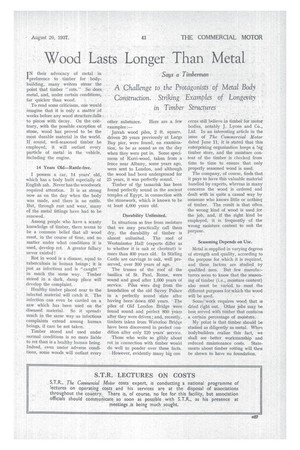Wood Lasts Longer Than Metal
Page 37

If you've noticed an error in this article please click here to report it so we can fix it.
Says a Timberman
A Challenge to the Protagonists of Metal Body Construction. . Striking Examples of Longevity in Timber Structures
I N their advocacy of metal in preference to timber for bodybuilding, many writers stress the point that timber " rots." So does metal, and, under certain conditions, far quicker than wood.
To read some criticisms, one would imagine that it is only a matter of weeks before any wood structureifalls to pieces with decay. On the contrary, with the possible exception of stone, wood has proved to be the most durable material in the world. If sound, well-seasoned timber be employed, it will outlast every particle of metal in the vehicle, including the engine.
19 Years Old—Rattle-free.
I possess a car, 14 years' old, which has a body built especially of English ash. Never has the woodwork required attention. It is as strong now as on the day when the body was made, and there is no rattle. But, through rust and wear, many of the metal fittings have had to be renewed.
Among people who have a scanty knowledge of timber, there seems to be a common belief that all wood must, in the course of time, and no matter under what conditions it is used, develop rot. A greater fallacy never existed Rot in wood is a disease, equal to tuberculosis in human beings ; it is just as infectious and is " caught " in much the same way. Timber stored in a dark, damp place will develop the complaint..
Healthy timber placed near to the infected material will catch it. The infection can even be carried on a saw which has been used on the diseased material. So it spreads much in the same way as infectious complaints extend among human beings, if care be not taken.
Timber stored and used under normal conditions is no more liable to rot than is a healthy human being. Indeed, even under adverse conditions, some woods will outlast every other substance. Here are a few examples :— Jarrah wood piles, 2 ft. square, driven 20 years previously at Largs Bay pier, were found, on examination, to be as sound as on the day when they were put in. Some specimens of Karri-wood, taken from a fence near Albany, some years ago, were sent to London, and although the wood had been underground for 25 years, it was perfectly sound.
Timber of tke tamarisk has been found perfectly sound in the ancient temples of Egypt, in connection with the stonework, which is known to be at least 4,000 years old.
Durability Unlimited.
In situations so free from moisture that we may practically call them dry, the durability of timber is almost unlimited. The roof of Westminster Hall (experts differ as to whether it is oak or chestnut) is more than 400 years old. In Stirling Castle are carvings in oak, well preserved, over 300 years of age.
The trusses of the roof of the basilica of St. Paul, Rome, were sound and good after 1,000 years of service. Piles were dug from the foundation of the old Savoy Palace in a perfectly sound state after having been down 650 years. The piles of Old London Bridge were found sound and perfect 800 years after they were driven ; and, recently, timbers taken from Waterloo Bridge have been discovered in perfect condition after only 120 years' service.
Those who write so glibly about rot in connection with timber would do well to ponder over these facts.
However, evidently many big con
cerns still believe in umbel' for motor bodies, notably J. Lyons and Co., Ltd. In an interesting article in the issue of The Commercial Motor dated June 11, it is stated that this enterprising organization keeps a big timber store, and the moisture content of the timber is checked from time to time to ensure that only properly seasoned wood is used.
The company, of course, finds that it pays to have this valuable material handled by experts, whereas in many concerns the wood is ordered and dealt with in quite a casual way by someone who knows little or nothing of timber. The result is that often the wrong kind of wood is used for the job, and, if the right kind be employed, it is frequently of the wrong moisture content to suit the purpose.
Seasoning Depends on Use.
Metal is supplied in varying degrees of strength and quality, according to the purpose for which it is required, and these factors are studied by qualified men: But few manufacturers seem to know that the seasoning of timber (i.e., moisture content) also must be varied to meet the different purposes for which the wood will be used. •
Some work requires wood. that is dried right out. Other jobs may be best served with timber that contains a certain percentage of moisture.
My point is that timber should be studied as diligently as metal. When bodybuilders realize this fact, we shall see better workmanship and reduced maintenance costs. Statements about timber rotting will then be shown to have no foundation.




















































































